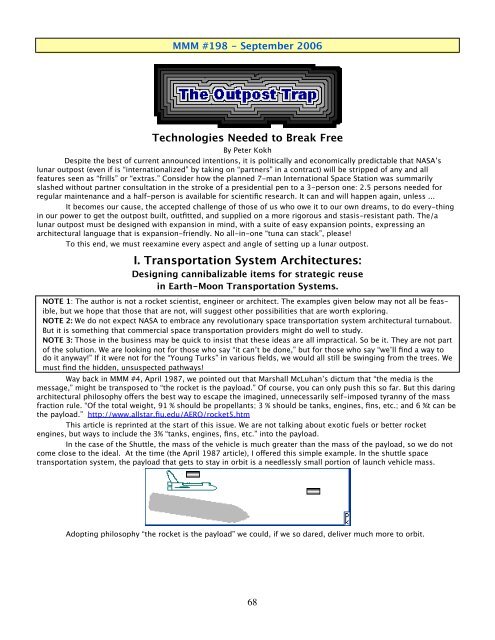Space Transportation - mmmt_transportation.pdf - Moon Society
Space Transportation - mmmt_transportation.pdf - Moon Society
Space Transportation - mmmt_transportation.pdf - Moon Society
You also want an ePaper? Increase the reach of your titles
YUMPU automatically turns print PDFs into web optimized ePapers that Google loves.
MMM #198 - September 2006<br />
Technologies Needed to Break Free<br />
By Peter Kokh<br />
Despite the best of current announced intentions, it is politically and economically predictable that NASA’s<br />
lunar outpost (even if is “internationalized” by taking on “partners” in a contract) will be stripped of any and all<br />
features seen as “frills” or “extras.” Consider how the planned 7-man International <strong>Space</strong> Station was summarily<br />
slashed without partner consultation in the stroke of a presidential pen to a 3-person one: 2.5 persons needed for<br />
regular maintenance and a half-person is available for scientific research. It can and will happen again, unless ...<br />
It becomes our cause, the accepted challenge of those of us who owe it to our own dreams, to do every-thing<br />
in our power to get the outpost built, outfitted, and supplied on a more rigorous and stasis-resistant path. The/a<br />
lunar outpost must be designed with expansion in mind, with a suite of easy expansion points, expressing an<br />
architectural language that is expansion-friendly. No all-in-one “tuna can stack”, please!<br />
To this end, we must reexamine every aspect and angle of setting up a lunar outpost.<br />
I. <strong>Transportation</strong> System Architectures:<br />
Designing cannibalizable items for strategic reuse<br />
in Earth-<strong>Moon</strong> <strong>Transportation</strong> Systems.<br />
NOTE 1: The author is not a rocket scientist, engineer or architect. The examples given below may not all be feasible,<br />
but we hope that those that are not, will suggest other possibilities that are worth exploring.<br />
NOTE 2: We do not expect NASA to embrace any revolutionary space <strong>transportation</strong> system architectural turnabout.<br />
But it is something that commercial space <strong>transportation</strong> providers might do well to study.<br />
NOTE 3: Those in the business may be quick to insist that these ideas are all impractical. So be it. They are not part<br />
of the solution. We are looking not for those who say “it can’t be done,” but for those who say “we’ll find a way to<br />
do it anyway!” If it were not for the “Young Turks” in various fields, we would all still be swinging from the trees. We<br />
must find the hidden, unsuspected pathways!<br />
Way back in MMM #4, April 1987, we pointed out that Marshall McLuhan’s dictum that “the media is the<br />
message,” might be transposed to “the rocket is the payload.” Of course, you can only push this so far. But this daring<br />
architectural philosophy offers the best way to escape the imagined, unnecessarily self-imposed tyranny of the mass<br />
fraction rule. “Of the total weight, 91 % should be propellants; 3 % should be tanks, engines, fins, etc.; and 6 %t can be<br />
the payload.” http://www.allstar.fiu.edu/AERO/rocket5.htm<br />
This article is reprinted at the start of this issue. We are not talking about exotic fuels or better rocket<br />
engines, but ways to include the 3% “tanks, engines, fins, etc.” into the payload.<br />
In the case of the Shuttle, the mass of the vehicle is much greater than the mass of the payload, so we do not<br />
come close to the ideal. At the time (the April 1987 article), I offered this simple example. In the shuttle space<br />
<strong>transportation</strong> system, the payload that gets to stay in orbit is a needlessly small portion of launch vehicle mass.<br />
Adopting philosophy “the rocket is the payload” we could, if we so dared, deliver much more to orbit.<br />
68















